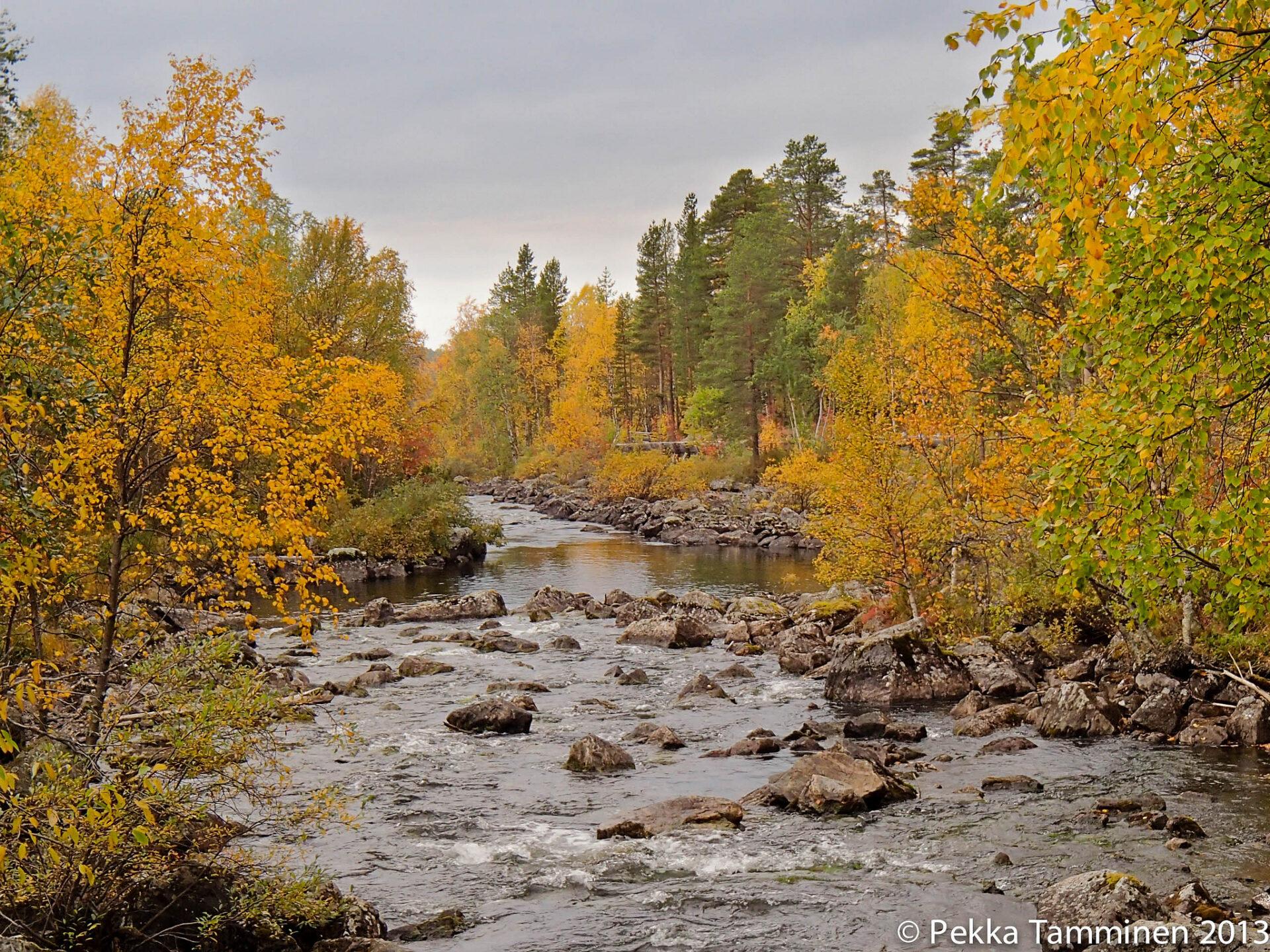Skolt Sámi salmon fishing in the Näätämö River

Case study basic information
Location: Inari Municipality
Time frame: 1947 to date
Drivers: climate change, forestry, tourism, industry
Summary
For thousands of years, Skolt Sámi traditional fishing communities have been dependent on the highly productive salmon population in the Näätämö River, bordering Finland and Norway. For Skolt Sámi communities, salmon and salmon fishing are key aspects of their traditions and cultural livelihoods. However, climate, development, and other environmental factors are now threatening the Näätämö River salmon population, and as a result, the Skolt Sámi’s traditional way of life.
The Näätämö River flows through the Inari municipality in northern Finland, crosses the boarder to the Neiden fiord in Norway, and enters the Atlantic Ocean. Skolt Sámi live along the coast of the river and have a deep understanding of the Näätämö River area. They also have a breadth of traditional ecological knowledge about toponymic place names, cosmologies, salmon catch and weather statistics, salmon spawning sites, among other cultural and ecological facts. The Skolt Sámi’s holistic view of nature makes this a strong social-ecological system (SES).
The Skolt Sámi’s sustenance, economy, and cultural livelihoods are dependent on the health of a sustainable salmon population. Like many sources of traditional livelihood, the Näätämö River salmon population is suffering from diverse biophysical and social pressures.
Climate change affects salmon populations in the Näätämö River in several ways. It increases precipitation variability, which results in river water depth and flow variability and higher temperature. Yet, above a certain temperature, salmon’s living conditions deteriorate, and when water depth is too low, salmon may be unable to swim upstream due to shallow river areas or frozen rivers in the winter.
At the same time, mining, forestry, hydropower and tourism have dramatically increased around the Näätämö River, contributing to environmental changes over the past decades. Hydropower has impacted river depth and flow. Nutrient loading from industries such as tourism and forestry have increased eutrophication, contributing to the degradation of salmon spawning sites. Disease and parasites from farmed salmon also impact wild salmon populations.
Against this background, Skolt Sámi communities rely on at least two sources of adaptive capacity. First, Skolt Sámi rely on a variety of fish species, therefore increasing their resilience to a drastic change in salmon availability. Also, these communities have a system of rules and norms deeply entrenched in traditional livelihoods and knowledge, which ensures sustainable use of the fish stocks: to cope with and adapt to changing socio-ecological conditions, these communities alter their catch sizes per season based on their observations of changes in salmon behavior and abundance.
While the local governance system contributes to Skolt Sámi communities’ resilience to ongoing socio-ecological changes, higher levels of governance rather undermines it. Skolt Sámi do not have legal ownership rights over the land, and therefore are at the mercy of the Finnish and Norwegian national governments natural resource management decisions.
These national authorities do not share the same worldview as Skolt Sámi peoples, and tend to not take indigenous management practices into consideration. The same is true for the regional Finnish Forest authority. Relations between Sámi communities and national authorities have actually been characterized by conflict and mistrust over decades, as illustrated by the 1917 and 1944 forced relocation events.
Furthermore, although the Skolt Sámi Village Council is recognized by the Finnish government and has agreement signing privileges when it comes to salmon resources in Näätämö River, the indigenous communities have to compete for fish stocks with non-indigenous residents from Norway and Finland that also rely on salmon for economic livelihoods. Moreover, even though the loss of ecosystem provisioning services is beared mostly by Skolt Sámi communities, incomes from tourist fishing permits go to the Finnish government.
Methods and Tools
The methodology for this case study was desk study and expert interview. The information collected was organized according to a template specially developed to capture information from a socio-ecological resilience perspective (the template can be found at http://www.arctic-council.org/arr/resources/).
This case study is one of several case studies compiled across the Arctic to inform a qualitative comparative analysis (QCA) of socio-ecological regime shifts in the Arctic that will feature in the final Arctic Resilience Assessment. The QCA methodology allows for a holistic view of cases in an extended geographic region and for addressing multiple causality. The QCA analysis will contribute to identify patterns that will allow for further analysis across the cases.
Lessons Learnt
- The Skolt Sámi have depended on the salmon population for thousands of years, but with increased industry in the surrounding region and climate change, they have been forced to adapt.
- Using observation to determine sustainable catch sizes and by fishing other species, Skolt Sámi are implementing strategies to adapt to the decrease in salmon populations.
- In addition to the increased stress on the ecosystem as a result of industry around the river, the uneven power dynamic between the communities and national authorities decreases the indigenous peoples’ ability to adapt and benefit from the increased tourism, fishing, etc being experienced in the region.
This case study demonstrates the role of different levels of governance in strengthening or weakening local communities’ socio-ecological resilience. In this specific case, co-management has been suggested to improve the adaptive capacity of the Skolt Sámi peoples.
References
- Mustonen, T. (Snowchange Cooperative), Feodoroff, P. (Saa’mi Nue’tt). (2013). Ponoi and Näätämö River Collaborative Management Plan. Waasa Graphics Oy.
- Mustonen, T. Pers. Comm. (2014).
Authors
This ARA case study was elaborated by Jessica Spijkers, Andrea Utas, Katja Malmborg, Gustav Grusell, Hannah Griffiths, Carmen Seco Pérez, Fernando Remolina, and Lara Dominguez, within the framework of the 2014 Resilience Thinking course at the Stockholm Resilience Centre (Stockholm University).

Comments
There is no content